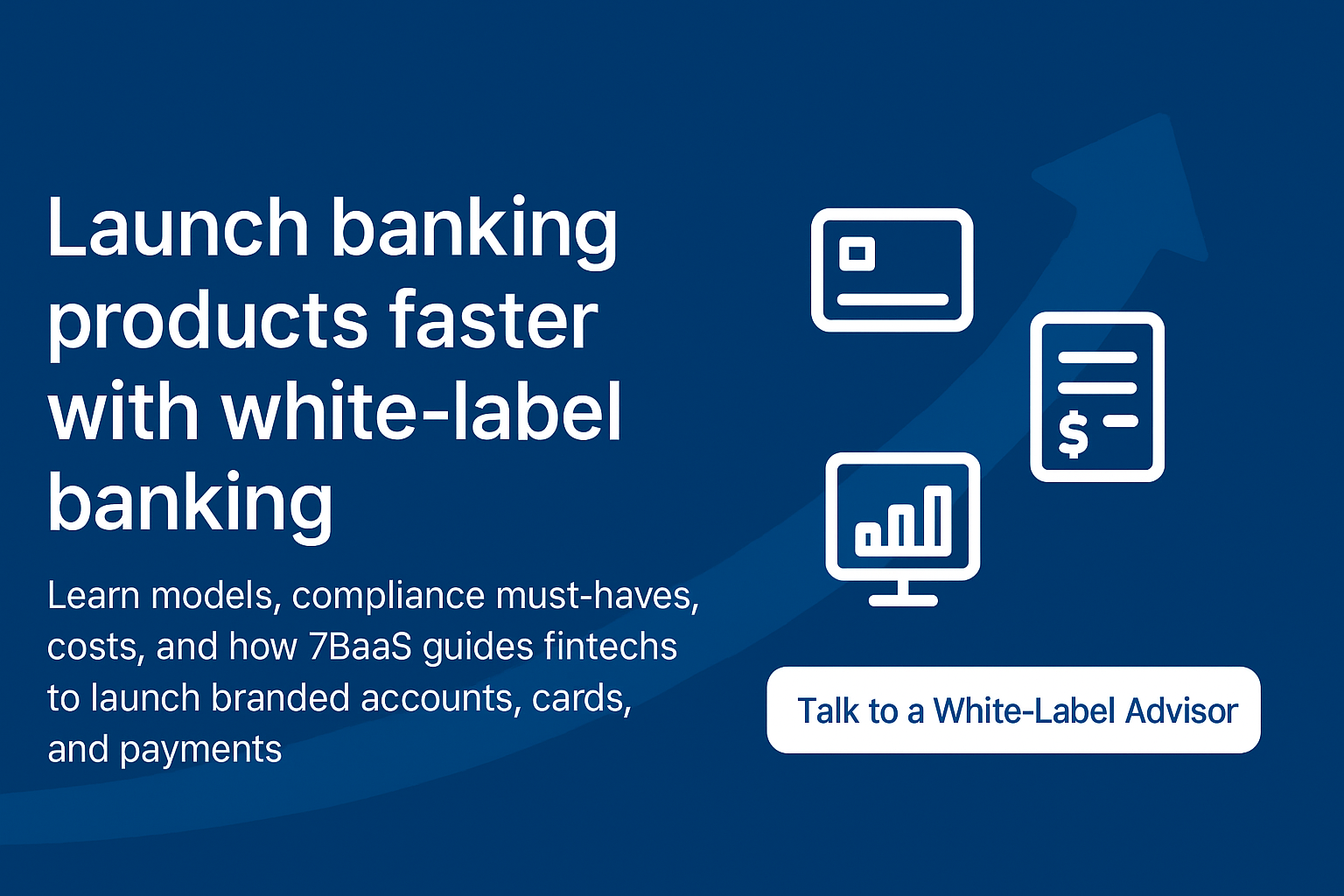Introduction
Launching a banking-grade product is expensive, slow, and heavy on compliance. For many fintech startups and challengers, building everything from scratch — from core banking to card issuing, compliance, and payments rails — is simply not viable. That’s where white-label banking comes in: it lets you launch customer-ready financial products under your brand while leveraging proven infrastructure and regulatory cover. This guide explains what white-label banking is, who should use it, how the model works, compliance considerations, costs and timelines, key partners to choose, common pitfalls, and how 7BaaS helps you go live faster and safer.
What is White-Label Banking?
White-label banking (also called Banking-as-a-Service or BaaS in some contexts) is a model where an established banking or fintech infrastructure provider supplies the back-end technology, compliance frameworks, and sometimes regulated licenses — while your brand owns the customer-facing experience. In practice this can include: accounts/IBANs, card issuance, payment acceptance, KYC & AML tools, and reporting. The startup focuses on product, UX, and growth while the white-label partner manages the heavy lifting.
Who Should Consider White-Label Banking?
-
Startups wanting to launch fast without long licensing timelines.
-
Companies testing banking or payments features without committing to full bank builds.
-
Non-fintech brands (retail, telecoms, marketplaces) adding financial services.
-
High-risk verticals seeking compliant solutions without building in-house.
If you want to offer bank-like services — cards, wallets, FX, or account rails — but don’t want to build a core banking stack or manage complex compliance, white-label is the pragmatic route.
Core Components of a White-Label Offering
-
Banking Infrastructure & Accounts: Managed IBANs, custodial or client accounts, reconciliation tools.
-
Card Issuing & Processing: Virtual & physical cards, BIN sponsorship, and payment processor integration.
-
KYC / AML & Compliance: Customer onboarding, transaction monitoring, SAR/STR reporting.
-
APIs & Integrations: Developer-friendly endpoints for account creation, payments, statements.
-
User Experience & Branding: Front-end UI/UX, mobile apps, and branded communications.
7BaaS helps assemble these building blocks through our Banking Brand Setup packages and compliance services. See our Banking Brand Setup and Compliance & Regulatory Consulting pages for details.
Licensing & Regulatory Considerations
Even when you use a white-label partner, regulatory exposure depends on structure: are you using a sponsored license, agent bank, or is your entity the regulated party? Important considerations:
-
Who Holds the License? Some models have the partner hold the regulatory license (easier, faster), while others require you to hold a license (more control, more responsibility).
-
AML/KYC Obligations: You and/or your partner must ensure robust AML/CTF programs. If your brand owns customer relationships, regulators will expect you to have compliance controls in place. 7BaaS can develop and implement your AML program via our Compliance Consulting.
-
Data & Privacy: Cross-border data flows and privacy rules (PIPEDA, GDPR for EU customers) must be respected.
-
Card BIN Sponsorship & Processor Rules: Card programs require BIN sponsorship and clear terms with processors; ensure transparency on chargebacks and liability.
-
Virtual Asset Overlays: If you plan to link crypto rails, ensure your partner and setup meet any crypto licensing or VASP requirements — 7BaaS supports this via our Crypto & Virtual Asset Licensing services.
Models of White-Label Partnership (Pros & Cons)
-
Sponsored / Partner Bank Model
-
Pros: Fast time-to-market, partner handles license and banking compliance.
-
Cons: Less product control; regulatory dependency on partner.
-
-
License-Holding Brand Model
-
Pros: Greater control, better long-term margins.
-
Cons: Requires you to secure licenses (e.g., EMI/MSB equivalents), build compliance teams. 7BaaS supports companies wanting their own structure through Company Formation and licensing guidance.
-
-
Hybrid Model
-
Pros: Gradual transition — start sponsored, then migrate to your license.
-
Cons: Requires careful contractual planning and migration playbooks.
-
Costs & Timeframes
White-label paths vary widely:
-
Sponsored model: Often 4–12 weeks to launch (depending on integration complexity). Costs can be mostly operational (setup fees + per-user or per-transaction pricing).
-
License-holding model: Incorporation + licensing + compliance setup can take 2–6 months (or longer in some jurisdictions) and requires professional fees (legal, compliance, auditors).
-
Ongoing: Transaction fees, BIN fees, card costs, AML software and staff, plus periodic audits.
7BaaS can provide a clear, tailored estimate depending on your chosen model and target geographies. See our Banking Brand Setup for typical package components.
Integration & Tech Checklist (Before You Start)
-
Clear product spec and user journeys.
-
API readiness (developer docs, webhooks).
-
Data flow & privacy mapping.
-
Customer onboarding and KYC flows.
-
Reconciliation and settlement processes.
-
Contingency plans for outages and fraud.
A pre-launch readiness checklist reduces launch friction — 7BaaS helps teams test and validate all integrations.
Common Mistakes & How to Avoid Them
-
Choosing only on price: Low-cost partners may cut corners on compliance or reliability.
-
Neglecting migration planning: If you plan to move from sponsored to independent license later, plan the migration early.
-
Understaffing compliance: Even with a partner, your brand may be expected to play a role in KYC and SAR reporting.
-
Ignoring UX for compliance: Overly burdensome KYC can kill conversions—build smart, risk-based KYC flows.
7BaaS works with you to balance regulatory robustness and user experience.
Case Study Snapshot (Hypothetical)
A fintech wanted to launch prepaid cards + wallets across three markets. Using a sponsored white-label partner, they launched in 8 weeks, achieved early product-market fit, then partnered with 7BaaS to design an independent compliance program to transition to their own issuance license in year two — improving margins and product control.
How 7BaaS Helps You Launch a White-Label Banking Product
7BaaS combines regulatory guidance, company formation, compliance frameworks, and integration support so you can focus on product growth:
-
White-Label Banking Brand Setup: End-to-end launch packages for branded accounts, cards, and payout rails. Learn more at Banking Brand Setup.
-
Compliance & Regulatory Consulting: AML, KYC, monitoring, and audit-readiness via Compliance & Regulatory Consulting.
-
Company Formation & Licensing Advice: Fast incorporation and licensing strategy via Company Formation and our licensing services.
-
Crypto & Virtual Asset Support: If you need crypto rails or VASP compliance, see Crypto & Virtual Asset Licensing.
Ready to Launch Your Banking Brand?
White-label banking is the fastest path to market for startups that want banking-grade features without building everything from scratch. Whether you want a sponsored solution to test the market or a long-term licensed strategy, 7BaaS will architect the right approach.
Contact 7BaaS today and we’ll scope a plan tailored to your product, risk profile, and growth targets.
FAQs —
1. What is white-label banking?
White-label banking (or Banking-as-a-Service) allows a fintech or brand to offer bank-like products (accounts, cards, payments) under its brand while using another provider’s banking infrastructure, compliance, and sometimes license.
2. What’s the difference between a sponsored model and a license-holding model?
In the sponsored model a partner bank or provider holds the license and handles compliance; in the license-holding model your company holds the license — offering more control but more regulatory responsibility.
3. How fast can I launch with a white-label solution?
A sponsored white-label launch can take 4–12 weeks depending on integrations. If you plan to hold your own license, the timeline is longer (often 2–6 months for setup and compliance).
4. Who is responsible for AML/KYC in a white-label arrangement?
Responsibility depends on contract structure. If the partner holds the license, they often bear core regulatory obligations, but your brand may still need to handle customer onboarding and KYC processes. Clarify this in the contract.
5. Can I issue both virtual and physical cards via white-label banking?
Yes. Most white-label providers offer virtual and physical card issuance through BIN sponsorship and processor integrations, subject to program rules and eligibility.
6. Can I later move from a sponsored model to my own license?
Yes — many companies start sponsored and later migrate to their own licensing model. This requires careful migration planning and compliance program scaling.
7. What are the major costs of white-label banking?
Costs include setup/integration fees, per-account or per-transaction charges, card costs, BIN fees, compliance tooling, and ongoing partner fees. Sponsored models usually have lower upfront licensing costs.
8. How does white-label impact brand trust?
With high-quality partners and transparent terms, white-label banking can strengthen brand trust by enabling reliable, secure services quickly. Choose partners with strong compliance and uptime records.
9. How can 7BaaS help with white-label banking?
7BaaS offers end-to-end Banking Brand Setup, compliance consulting, company formation, and migration planning to ensure your white-label launch is compliant and scalable. See our Banking Brand Setup.



